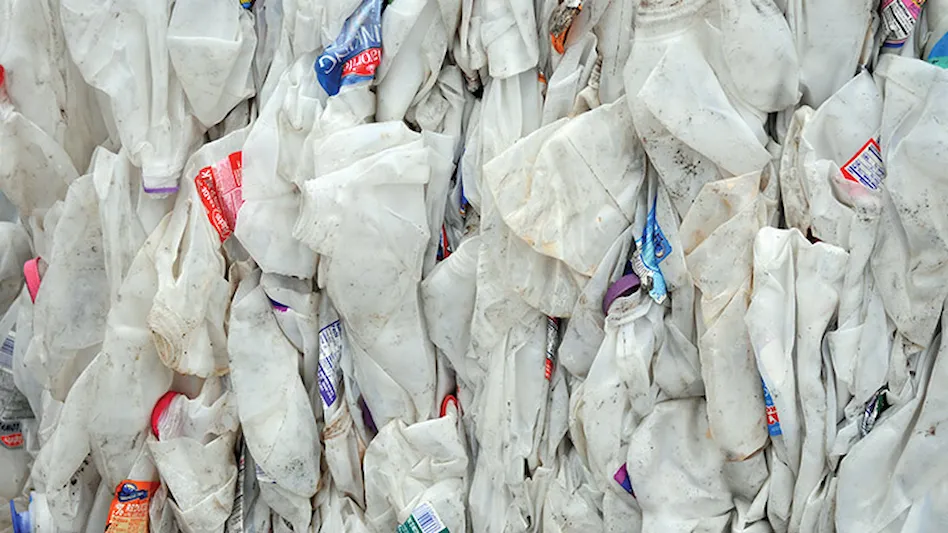
Photo: Shutterstock
Plastic bottle recycling grew 97 million pounds in 2014, increasing 3.3 percent to top 3 billion pounds, according to figures released jointly by the Association of Plastic Recyclers (APR) and the American Chemistry Council (ACC). The organizations say this amounts to a 31.8 percent recycling rate in 2014.
Trends in plastics recycling highlighted in the report, “National Post-Consumer Plastics Bottle Recycling Report,” include:
- Single-stream collection of household recyclables continues to grow, resulting in higher participation rates.
- Use of plastic bottles in packaging applications is expanding but is offset by continued lightweighting and increased use of concentrates with smaller, lighter bottles.
- Lack of access to away-from-home recycling continues to be a barrier to increased collection.
During 2014, the collection of high-density polyethylene (HDPE, or No. 2 plastic) bottles—a category that includes milk jugs and household cleaner and detergent bottles—rose to nearly 1.1 billion pounds, a gain of more than 62 million pounds from 2013, for a recycling rate of 33.6 percent.
According to the report, a higher percentage of postconsumer plastic bottle material was processed by domestic reclaimers in 2014. Exports of all postconsumer plastic bottles rose slightly (in pounds) but, at 21.9 percent, fell to the lowest percentage of exports in six years. This was because the amount of bottles collected increased faster than exports did, the organizations say, adding that the drop in exports may reflect the strength of the U.S. dollar and growth in domestic reclamation capacity.
U.S. reclamation capacity for HDPE increased to its highest level ever in 2014. Exports of HDPE bottles rose from 15.6 to 19.7 percent (218 million pounds) of domestically collected material, and domestic reclaimers processed approximately 951 million pounds of HDPE bottles in 2014.
“The message to American consumers is that plastic bottles are valuable resources even after they’ve been used,” says Steve Alexander, executive director of APR. “Americans generated an estimated $730 million in recycled plastic bottles in 2014. The simple act of recycling helps generate local revenue, supports recycling jobs and enables us to continue to benefit from these useful resources.”
Steve Russell, vice president of plastics for the ACC, says, “This report clearly illustrates 25 years of year-over-year growth in recycling plastic bottles. Plastics help reduce energy use and conserve resources—and after use, these efficient products and packages are increasingly valued as recycled materials. We’re confident that plastics recycling will continue to grow, and we will continue working to accelerate that growth.”
This year’s survey also found that the collection of polypropylene (PP, No. 5) bottles increased 28.3 percent, reaching 79.5 million pounds, for a recycling rate of 44.9 percent. Domestic processing of postconsumer PP bottles grew to 65.3 million pounds. PP bottles deliberately recycled as PP (instead of being blended with HDPE) rose from 44.2 million pounds in 2013 to 45.6 million pounds in 2014.
Although PP caps, closures and nonbottle containers are widely collected for recycling in the United States, these data are presented in a separate report on recycling nonbottle rigid plastics, which will be released in the coming months, the organizations say.
Together, polyethylene terephthalate (PET, No. 1) and HDPE bottles continue to make up nearly 97 percent of the U.S. market for plastic bottles, with PP comprising 1.9 percent, LDPE (low-density polyethylene) 0.8 percent and PVC (polyvinyl chloride) 0.4 percent, according to the report.
Data on PET recycling referenced in the report were separately funded and published by APR and the National Association for PET Container Resources. A separate report, “2014 Report on Post-Consumer PET Container Recycling Activity,” is available on APR’s website.
The 25th annual “National Post-Consumer Plastics Bottle Recycling Report” is based on a survey of reclaimers conducted by Moore Recycling Associates Inc. of Sonoma, California.
Resources for municipal recyclers are available at www.recycleyourplastics.org.